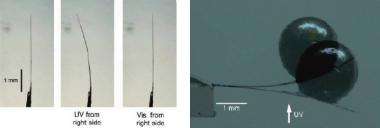October 1, 2010 feature
Crystal cantilever lifts objects 600 times its own weight (w/ Video)

(PhysOrg.com) -- For a long time, scientists have been trying to transform the collective movements of tiny molecules into useful mechanical work. With this goal in mind, a team of researchers from Japan has developed a crystal cantilever that exhibits reversible bending upon alternate irradiation with ultraviolet (UV) and visible light. They've demonstrated that the crystal cantilever can lift metal balls that weigh up to 600 times more than the cantilever itself. In this process, the crystal's photogenerated molecular-scale shape change generates a very large amount of stress - more than 100 times larger than the stress produced by biological muscles - to induce the macroscale movement.
Masakazu Morimoto and Masahiro Irie from Rikkyo University in Tokyo, Japan, and the Japan Science and Technology Agency have published their study on the crystals in a recent issue of the Journal of the American Chemical Society.
The current study expands on the scientists' previous paper, in which they showed that the alternate irradiation of UV and visible light on a crystal can can cause shape changes in the crystal's molecules, which can result in a macroscale shape change of the crystal material. Although the previous paper showed that molecular-scale events could induce macroscale movements, the crystals were too small and fragile to be used in real-world applications.
In the current study, Morimoto and Irie used a two-component cocrystal to achieve greater strength and durability. The cocrystal is a thin, rectangular plate of 1-5 mm in length, 0.2-1.5 mm in width, and 10-50 µm in thickness.
When irradiated with UV light (365-nm wavelength), the crystal bends away from the light source and turns blue. The scientists explained that the bending is due to the expansion of the crystal lattice induced by the shape change of the component diarylethene molecules. The crystal continues to bend until the UV light is switched off, and the crystal keeps its bent shape in the dark.
When irradiated with visible light (440-nm wavelength), the crystal returns to its original straight shape and the blue color disappears. The scientists could repeat the photostimulated bending cycle more than 250 times without observing any damage to the crystal.
The scientists also demonstrated that the crystals could be used to lift heavy metal balls. Acting as a cantilever arm, a 0.17-mg crystal could lift a 2-mm, 46.77-mg lead ball, and a 0.18-mg crystal could lift a 3-mm, 110.45-mg steel ball, which was 614 times heavier than the crystal. These experiments showed that the crystal cantilever arm could generate a strong force (1.1 mN) and perform large mechanical work (0.43 microJ).
As the scientists noted, another example of a system which exhibits mechanical movement based on the structural changes of individual molecules is biological muscles, in which the molecular-scale movements of proteins generate muscle movement. Both muscles and the crystal cantilever undergo stress, but the stress generated by the crystal (44 MPa) was estimated to be more than 100 times larger than that generated by muscles (0.3 MPa). The crystal's stress was comparable to that of piezoelectric materials (50 MPa), which are known for their ability to convert mechanical stress into electricity.
“The large stress is ascribed to a large Young's modulus of the molecular crystal,” Irie told PhysOrg.com. “It is known that the molecular-scale shape change of molecules can produce very large local stress, 40-60 kbar, which is close to the pressure needed to convert graphite into diamond. The large stress produced by individual molecules induces the shape change of the crystal.”
In the future, the scientists predict that the light-driven crystal actuators could have applications in micro- and nanomechanics, such as for manipulating biological cells and serving as light-driven valves in microreactors.
More information: Masakazu Morimoto and Masahiro Irie. “A Diarylethene Cocrystal that Converts Light into Mechanical Work.” J. Am. Chem. Soc. DOI:10.1021/ja105356w
Copyright 2010 PhysOrg.com.
All rights reserved. This material may not be published, broadcast, rewritten or redistributed in whole or part without the express written permission of PhysOrg.com.


















